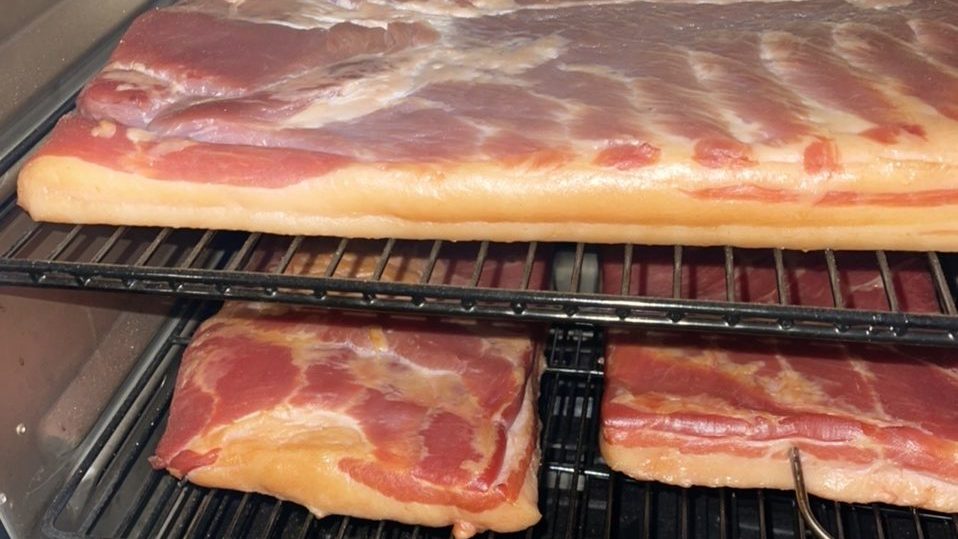B is for Bacon, homemade Artisanal Applewood Smoked Bacon Bacon to be exact – Yep! I make my own bacon and it is better and less expensive than anything I can buy at the store. Over the years my brother and I have tried several different methods and process and what I have published below is what we have settled upon through trial and error. Not only is the process simple, it produces some of the best bacon I haver ever had.
Disclaimer: This is NOT an accepted recipe for you to follow, it is MY method and may be contrary to safe or established meat curing methods and practices. DO YOUR OWN RESEARCH. I am NOT a professional, nor do I have any credentials or formal training in this field.I suggest that ANYBODY curing any kind of meat read and fully understand the process, chemistry and USDA guidelines for cured meats. Please see links in the footer!
To be clear: Curing meat improperly can result in sickness or death from botulism or other food born illness. Raw meat smoked at low temperature is a prime incubator for botulism. I make absolutely no claim as to the accuracy or safety of this information, calculations or methods. Use this information at your own risk!
Artisan Smoked Bacon
Homemade bacon is not hard to male, but there are dozens of recipes and opinions as to what works best or tastes best. Most methods require curing pork bellies in a concentrated wet or dry brine. Consequently, the cured bacon can be extremely salty and must be soaked in water (to reduce the saltiness) prior to smoking. This is an iterative trial and error process of soaking and sampling that yields somewhat unpredictable results.
Likewise, choice of smoke flavor, temperature, type of smoker and time in the smoker also contribute to the finished product flavor. Charcoal or stick burners create numerous variables to manage. The goal here was to come up with a 100% repeatable process that will yield the same amazing homemade bacon every time.
Artisan vs commercially made bacon? Quite simply put, real sugar vs hfc (High Fructose Corn Syrup). Real maple vs artificial flavor. Real smoke vs artificial smoke and no other additives. Just pork belly, cure, sugar and smoke.
Bacon Equilibrium Cure
Please read the disclaimer above! Do not trust my math or equations, do your own research!
I am using a calculated “dry equilibrium cure” instead of the common “cure and soak” method where the finished saltiness is always variable. In short, the exact amount of cure for the meat is calculated so that the end product has the desired salt concentration and/or sweetness. There is no “extra” cure/salt to soak away once the meat is cured.
FDA guidelines indicate that nitrite levels in cured bacon should be somewhere between 120 parts per million and 200 parts per million depending on wet or dry cure with skin on or off. I am not going to get into the details, reasons, chemistry or different types of cures here. That is an (important) exercise for the reader.
Pink Cure #1 (aka Prague Powder) is 6.25% Sodium Nitrite and 93.75% regular salt.
MY target nitrite concentration is 156 ppm.
The amount of cure needed can be easily expressed as:
Cure weight in grams = (ppm sodium nitrite) * (weight of belly in grams) / (Sodium Nitrite %) / 1,000,000
For Pink Salt (Cure #1)
Cure #1 grams = 156 * belly weight (g) / .0625 / 1,000,000
My favorite recipe (via trial and error):
2% total salt
.5% white sugar
.5% maple sugar
Using a 5000g pork belly as an example:
156 * 5000 / .0625 / 1000000 = 12.48 grams of Cure #1
Total target salt concentration for the above recipe is 2%or 100g for the 5000g belly.
12.48g of Cure #1 contains 11.7g of salt. So I need to add 88.3g of salt (100g – 11.7g) to reach the desired concentration.
Target sugar is 25g (.5% of 5000g) of White sugar and 25g (.5% of 5000) of Maple Sugar to the cure mix.
I have built an equilibrium cure calculator with the above equations and the default bacon recipe above pre-loaded.
Curing Bacon
Please read the disclaimer above! the FDA has guidelines for cure times and methods. Read and understand them!
The cure is weighed and mixed then rubbed onto the SKINLESS belly. The belly is then placed into a vacuum bag (this ensures good contact on all sides) and refrigerated for ~7 days (about 1 day per mm of thickness), turning and gently messaging each day. The magic here is that the bacon cannot absorb more salt than needed and curing for extra days will not change the flavor profile or add to the saltiness. After 7 days the belly is removed from the bag and gently rinsed in the sink, NOT SOAKES. The goal here is jus to rinse of the belly and pat it dry to prepare for smoking.
Smoking Applewood Bacon
Please read the disclaimer above! This is where my method heavily deviates from most other published information.
I prefer to use a vertical pellet smoker because the heat and smoke profile are settable and predictable. In doing so I get the same results every time without having to manage temperature swings and the amount or quality of the smoke. I also prefer the flavor profile of applewood smoke, as it is smooth and not overpowering. Hickory is also very good but can be overpowering for some people.

Most smoking forums and members of the smoking community advise smoking bacon at an external temperature of 250 degrees Fahrenheit (or above) to an internal temperature between 160 and 190 degrees Fahrenheit (opinions vary), essentially fully cooking the meat with a hot exterior and an interior that ensures safety. This is to ensure that the cured pork belly spends very little time in the temperature danger zone (37.9°F – 118.4°F for botulism and 135°F for other pathogens) in the smokey (oxygen deficient) environment where botulism can thrive. Unfortunately Not only does this result in partially rendered fat, but it also changes the texture and flavor profile of the bacon. The pork belly will stop taking on smoke very quickly at such high external temperature.
I smoke at 140 for 4 hours – just above the “danger” zone but low enough for the pork belly to take on smoke and prevent the fat from rendering. Next,I then crank the temperature up to 170 for 30-40 minutes to ensure that the surface of the pork belly does spend considerable time above 160f. I do monitor the internal belly temperature via a probe but do not get too wrapped up in what it reads (see safety section). The pork belly is already fully cured and only being smoked for flavor and a safe final surface temperature.
Slicing Bacon
I slice on the medium to thick side using a professional slicer. This is up to you. I stack the slices (matchbook style) on wax paper a carrier and slip that into a vacuum bag, date and freeze. Done!
Bacon Curing Safety
My thoughts on this process are simple. The pork belly is a whole muscle, pathogens don’t grow inside whole muscle. The surface spends considerable time above 160f and the meat IS FULLY CURED BEFORE smoking. Furthermore, the homemade bacon will ALWAYS be fully cooked before consumption. Is this safe? I think it is, but if you ask in any of he smoking forums, you will be excoriated and guaranteed a certain death for even considering not taking the bacon to 190f in the smoker. I disagree – but again, this is MY method, you should read the disclaimer and do your own research.
This list below is not an exhaustive list by any means, but merely a place to start. Do your own research!
- USDA – Processing Inspectors’ Calculations Handbook
- USDA – Bacon – Food Safety
- USDA – Smoking Meat – Food Safety
- FDA Guidance – Botulism
-BeanAnimal




Add comment